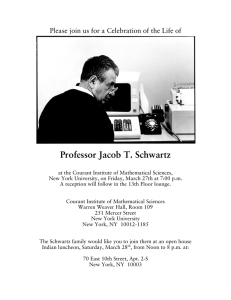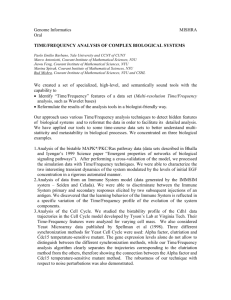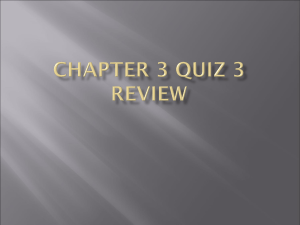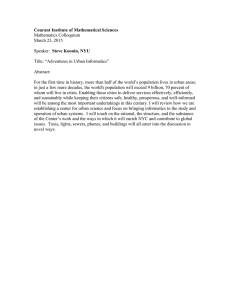INTERVIEW FOR 75 ANNIVERSARY COURANT INSTITUTE ANDY MAJDA
advertisement
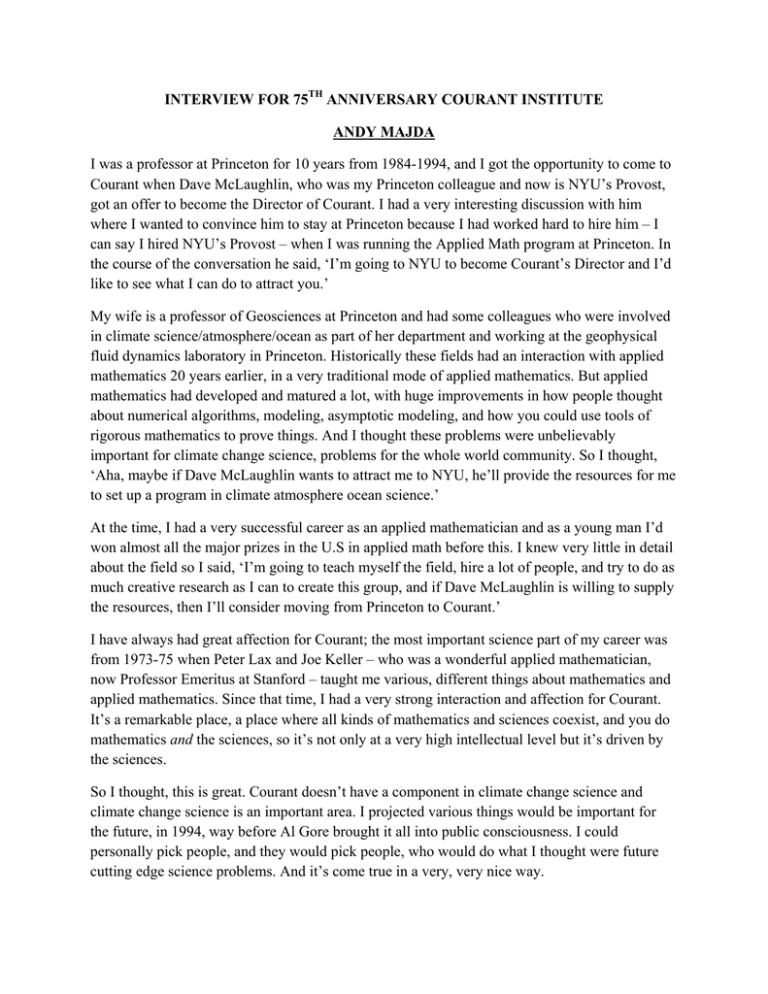
INTERVIEW FOR 75TH ANNIVERSARY COURANT INSTITUTE ANDY MAJDA I was a professor at Princeton for 10 years from 1984-1994, and I got the opportunity to come to Courant when Dave McLaughlin, who was my Princeton colleague and now is NYU’s Provost, got an offer to become the Director of Courant. I had a very interesting discussion with him where I wanted to convince him to stay at Princeton because I had worked hard to hire him – I can say I hired NYU’s Provost – when I was running the Applied Math program at Princeton. In the course of the conversation he said, ‘I’m going to NYU to become Courant’s Director and I’d like to see what I can do to attract you.’ My wife is a professor of Geosciences at Princeton and had some colleagues who were involved in climate science/atmosphere/ocean as part of her department and working at the geophysical fluid dynamics laboratory in Princeton. Historically these fields had an interaction with applied mathematics 20 years earlier, in a very traditional mode of applied mathematics. But applied mathematics had developed and matured a lot, with huge improvements in how people thought about numerical algorithms, modeling, asymptotic modeling, and how you could use tools of rigorous mathematics to prove things. And I thought these problems were unbelievably important for climate change science, problems for the whole world community. So I thought, ‘Aha, maybe if Dave McLaughlin wants to attract me to NYU, he’ll provide the resources for me to set up a program in climate atmosphere ocean science.’ At the time, I had a very successful career as an applied mathematician and as a young man I’d won almost all the major prizes in the U.S in applied math before this. I knew very little in detail about the field so I said, ‘I’m going to teach myself the field, hire a lot of people, and try to do as much creative research as I can to create this group, and if Dave McLaughlin is willing to supply the resources, then I’ll consider moving from Princeton to Courant.’ I have always had great affection for Courant; the most important science part of my career was from 1973-75 when Peter Lax and Joe Keller – who was a wonderful applied mathematician, now Professor Emeritus at Stanford – taught me various, different things about mathematics and applied mathematics. Since that time, I had a very strong interaction and affection for Courant. It’s a remarkable place, a place where all kinds of mathematics and sciences coexist, and you do mathematics and the sciences, so it’s not only at a very high intellectual level but it’s driven by the sciences. So I thought, this is great. Courant doesn’t have a component in climate change science and climate change science is an important area. I projected various things would be important for the future, in 1994, way before Al Gore brought it all into public consciousness. I could personally pick people, and they would pick people, who would do what I thought were future cutting edge science problems. And it’s come true in a very, very nice way. So I got the resources; also I was ready for change from Princeton. Princeton’s a quiet place but it’s fun to spend part of your time in New York City, and that was part of it. My wife is still at Princeton; my arrangement with Courant is that I spend part of my week down in Princeton -it’s the old Courant. It’s what Richard Courant and Kurt Friedrichs used to do. So I’m following their tradition. Courant took the tradition of Göttingen – of mathematics as science – and came here because of the circumstances of pre-WWII Nazi Germany and then was lucky enough to be blessed with this incredible group of young students: Joe Keller, Peter Lax, Cathleen Morawetz, Louis Nirenberg, Martin Kruskal – who became some of the most important scientists of their generation in mathematics. He nurtured them with Kurt Friedrichs in a remarkable way and was an entrepreneurial scientist, in a way most mathematicians are not. He’s one of the few mathematicians who capitalized on WWII; the physicists did, all to get extra funding from the government, but Courant realized that mathematics could do that too if it stressed its role as an applied mathematics institute. And he tied it to national security, of course. If you look at where he was coming from, WWII and the fate of a lot of the people he knew in Germany, you can see why he might be paranoid about national security. He recognized this early. Germany’s loss, our gain. Yes, that’s right. It’s the world’s gain, because Göttingen is now not very visible in science and the Courant Institute is the world’s most famous place to do mathematics and its applications. It’s an incredible success story. Back to my story: I hired people collegially with committees at the CI. I asked for a colloquium budget because I like to go to nice restaurants and since we had no visibility in the field, I would invite strategic people to nice dinners at nice restaurants. That worked very, very well. So I identified what I thought were important fields for the future, back around 1994, which I called some of the 800-pound gorillas of climate change science and climate atmosphere ocean. I thought there would be a special opportunity for a remarkable interaction between mathematics and climate change science, centered around what happens with clouds in the tropics. With the giant computer models that now try to predict climate change, the largest uncertainty is about clouds. They’ve since discovered in the last 10 or 15 years that the most important observational things are what’s happening in the tropics. That’s where there are the most clouds. So I embraced working in the field of tropical meteorology and clouds from the modern applied math milieu. And that’s been an incredible amount of fun in my personal research and very rewarding and satisfying – a lot of progress. Right now in the world community, the most important major field endeavors for doing observations of the world and field campaigns and improvements in predictions in computer models are all about the tropics, so this turned out to be a fantastic thing. And you were at the forefront of this? Yes. I was the driver, and then we have Olivier Pauluis who also works in these areas and contributes a lot. Another area I targeted then was sea ice modeling and glacier modeling. These were also another 800 pound gorilla in climate change models. The computer models that the Intergovernmental Panel on Climate Change run (the group of scientists that shared the Nobel Prize with Al Gore) don’t represent clouds well, and don’t represent sea ice or glaciers at all. They weren’t doing that back in 1994. So I said, ‘We should get someone in this area,’ and I didn’t exactly know who, so I went through my process of inviting people through networking and talking to various people, colloquium dinners, and we have a wonderful appointment we made there – David Holland, who is an expert in both glaciers and ice sheets. A few years ago he was the first person to do detailed measurements of the Greenland ice sheet collapse. He led the House of Representatives Science Committee on a summer excursion to show them the climate change there and explain it to them. He’s both a wonderful theoretician with computer models of ice and glaciers and someone who goes out and observes it. He’s now at the forefront of all of these issues, including whether the western Antarctic ice sheet will collapse and what is causing it. So he’s another paradigm example of the cutting edge of what we’re trying to do in the climate atmosphere ocean program. A third direction that I thought there was a great future in was how to use more sophisticated mathematics to quantify what we mean by predictions and errors in predictions because the climate system is so complicated, we don’t really know the model for the climate. We would only know the exact model if we could measure scales of millimeters in the climate and right now we’re typically measuring scales of hundreds of kilometers. So one has to start thinking about how to use sophisticated mathematics to understand how well you’re doing with the climate when you don’t know what the equations for the climate are. And they are horribly chaotic complex systems. We can predict the weather very well for three or four days and then it gets to be a tricky matter. People care very much about how much more will it rain or not rain in a whole season – this effects world food production, wars, droughts, all of these things. Severe extreme events of weather – are they climate induced or not. Again through the network, there’s a wonderful colleague, Richard Kleeman, who works in those areas. I also have spent a lot of time working in those areas, and there’s a great serendipity with some of our fantastic ideas in pure math at Courant, people like Raghu Varadhan’s ideas on probability theory and large deviation. We’re very friendly, we exchange ideas. That’s the great thing about Courant – the 13th Floor lounge. Probability plays a big role as a source of ideas for thinking about these things, together with a group of people who do what’s called chaotic dynamics. Professor Lai-Sang Young is an example where I’ve benefited a lot from the interaction. I’m a permanent visitor at the National Center for Atmospheric Research (NCAR) and I have a big interaction and collaboration with the people there. I’m one of their main sources of ideas. So I went from an outsider to being one of the main people they consult about things. Right now I have a very exciting collaboration with them – giant events in the tropics are called the MaddenJulian oscillation which for 40 to 50 days govern the rainfall in the tropics, and they are planetary scale. Rain events over 10,000 kilometers that move, propagating eastward, at a speed of about five meters a second. It happens seasonally, in a very chaotic, irregular way. None of the computer models can predict that. Working together, myself, one of my former Courant post docs who’s now a professor at the University of Victoria, Boualem Khouider, and two scientists from NCAR have developed the first successful simulation on one of the computer models of a Madden-Julian oscillation. And that’s just happened in the paper we’ve submitted this January, to be published in the most famous journal in the field of atmospheric science: The Journal of Atmospheric Science, run by the American Meteorological Society; my other AMS [the other being the American Mathematical Society]. The ways this new computer model treats clouds were developed by Khouider and myself using a lot of applied math. I have a theory, which is confirmed by these simulations, which was published in the Proceedings of the National Academy of Science last year. So I have a new theory that seems to explain what happens with the Madden-Julian oscillation – this is called the holy grail of meteorology, to find one. And we have the first simulations, all in the last year. My new theory for the Madden-Julian oscillation, which is the first theory to agree with the observation, was developed with a graduate student at CIMS, Sam Stechmann, when he was finishing his graduate studies. Sam has been both an NSF [National Science Foundation] and NOAA [National Oceanic and Atmospheric Administration] climate change post doc at UCLA and is on his way to a tenure track position in Math at the University of Wisconsin. Did you have anything to do with the making of the film An Inconvenient Truth? No, I’m not a science policy person. The Intergovernmental Panel on Climate Change has people who do the public relations for them who are scientists; those are the people who interacted with Gore. I’m interacting with the people from a theoretical level who are doing the actual science, not the public relations science. So I have a lot if interaction with people who work on the IPCC computer models but not interaction at a policy level – my own preference. Was the notoriety that the film brought to the field a good thing? Absolutely. Even though the IPCC models can’t accurately measure clouds and sea ice and glaciers, I think these are the best attempts people can make on extremely hard problems and public awareness of the importance of climate change and its ramifications is something great. Another area I felt was extremely important and which a very nice mathematical connection at Courant – because Courant is historically very famous going back to Joe Keller and Stoker, one of the original Courant founders – is waves. Turbulence is loaded with waves in the atmosphere and ocean because of stratification, meaning gravity changes the density with the depth of the atmosphere and oceans. So deeper water is heavier, and our atmosphere lower down is heavier than it is higher up. The fact that the earth spins, coupled with a 24-cycle of rotation from west to east, creates a lot of waves, as well as swirls – coherent structures which are vortices. The most famous examples of vortices are hurricanes. Turbulence is this random soup of all of these things, and it turns out to be very important in both the atmosphere and ocean. It’s something that a number of people at Courant know a lot about: myself, David McLaughlin, David Cai, Esteban Tabak. So this is a ripe area for interaction also. Right now, for example, people are discovering that the ocean just below the surface is extremely turbulent, contrary to what people thought, which is very important for the production of biological things like algae blooms, nutrient production. With climate change, we care a lot about how aerosols get up in the higher atmosphere. They’re condensation nuclei: the little particles that get up in the atmosphere are places where water will collect around them. These condensation nuclei then play a big role in what kind of tracer gases get up into the higher atmosphere, and those have a huge impact on global warming. Again, it’s a turbulence problem. So another area I wanted to work in when I set up the Center was to hire people who did that with a disciplinary perspective. So we have an expert in turbulence at the upper ocean whom we hired in the chaos group – Shafer Smith. For the future, in the administration’s hiring plan for the Courant Institute, we can make one more hire and the direction I think we should go in is data driven. This is a great mathematical problem: we have massive sets available, from observations from satellites and by various field campaigns going on, ships, sending up weather balloons. So what can we do to use these massive data sets to improve our understanding and prediction in an interactive way, with physics-based and math-based models? We don’t have anyone studying nutrients in the ocean – that’s another very exciting area of interaction. So what I tried to do was forecast the future in 1994 with the CAOS program and stay as current as I can, and I feel I’ve done a pretty good job. I have had the most wonderful collection of supportive colleagues, spanning the entire Institute. The most rewarding time of my science career has been my 16 years here. Courant had a big 60th birthday party for me in May of last year – one week of meetings talking about all these different fields I work in, 40 people giving lectures from around the country and around the world. David McLaughlin when he was Director was a wonderful supporter of this enterprise, and continues to be, as Provost.
